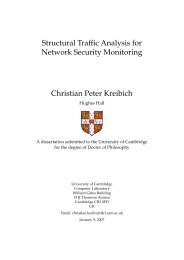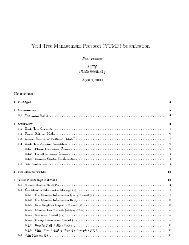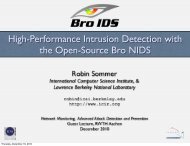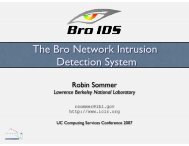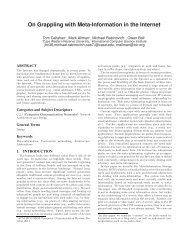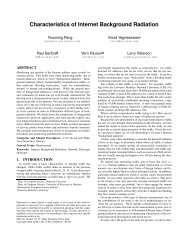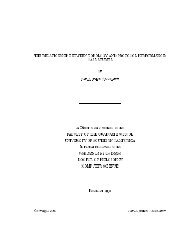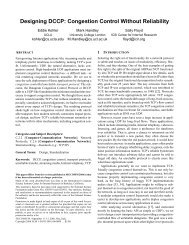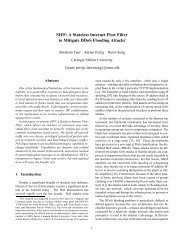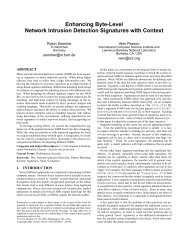WORM vs. WORM - The ICSI Networking and Security Group
WORM vs. WORM - The ICSI Networking and Security Group
WORM vs. WORM - The ICSI Networking and Security Group
Create successful ePaper yourself
Turn your PDF publications into a flip-book with our unique Google optimized e-Paper software.
ing. We call this an application-specific intrusion detection<br />
system. <strong>The</strong> system intercepts <strong>and</strong> inspects all messages<br />
sent to the application. Messages that match the signature<br />
of the current worm are not forwarded to the vulnerable<br />
application.<br />
<strong>The</strong> anti-worm code must also send itself to the originators<br />
of attacking worms for immunization <strong>and</strong> disinfection. Our<br />
current prototype uses an external payload for this purpose.<br />
While simple, it has a serious drawback: <strong>The</strong> extra traffic<br />
generated by the downloading of the payload may lead to<br />
network congestion. It may also lead to denial of service<br />
at the download site. Downloading the payload can always<br />
be done through a Content Delivery Network (e.g., Akami)<br />
which can reduce greatly the network traffic. A better way<br />
is to have the anti-worm re-generate itself. <strong>The</strong> anti-worm<br />
residing on a host has the complete information (code <strong>and</strong><br />
data) as an entity; it may be possible for it to assemble<br />
network messages that are an exact replication of itself. <strong>The</strong><br />
re-generation algorithm is quite sophisticated <strong>and</strong> requires<br />
further investigation.<br />
4.3 Experimentation with Real Worms<br />
Our process is evaluated through tests against the following<br />
well studied worms: Code-Red I, MSBlaster, <strong>and</strong> SQL<br />
Slammer. <strong>The</strong> OS platform used in our experiments is the<br />
Microsoft Windows 2000 Server with Service Pack 2, Microsoft<br />
SQL Server 2000, <strong>and</strong> Microsoft Internet Information<br />
Server (IIS) 3 . Tools were developed to simplify the experiments<br />
but some tasks were still performed manually (e.g.,<br />
restarting <strong>and</strong> reloading of the virtual machines). More work<br />
will be required to completely automate the process.<br />
Code Red I. Code-Red utilizes a buffer overflow in the<br />
indexing IIS plug-in, idq.dll. <strong>The</strong> worm utilizes an HTTP<br />
post request for default.ida containing a query parameter<br />
designed to overflow the buffer in this plug-in <strong>and</strong> overwrite<br />
the stack return address. <strong>The</strong> body of the post contains the<br />
worm’s payload, which is allocated <strong>and</strong> stored in the heap<br />
<strong>and</strong> can be of any practical size. Because of this the Code-<br />
Red worm message may contain the entire worm malcode<br />
<strong>and</strong> there is no need for an external payload. <strong>The</strong> worm<br />
message causes the return instruction pointer (EIP) to be<br />
overwritten with 0x7801,CBD3 which points to a piece of<br />
code in msvcrt.dll, a critical dll to the function of IIS. This<br />
code when disassembled is ”call ebx”, where EBX at this<br />
point contains a pointer to the posted data (the worm’s payload)<br />
[22].<br />
<strong>The</strong> length of the payload is 3,569 bytes, <strong>and</strong> the exploit<br />
vector is 470 bytes, totaling 4,039 for the entire message.<br />
<strong>The</strong> worm is transmitted in a single TCP flow. A simple<br />
heuristic based algorithm can easily guess the location to<br />
start replacing the worm code with the anti-worm code to<br />
be at α equal to 470. Since the protocol is HTTP <strong>and</strong> a<br />
post request is being made the generation may assume that<br />
the payload falls after the end of the HTTP header, which<br />
is always ended with 0x0D0A,0D0A. This case will yield<br />
a successful anti-worm in a single test. In the case where<br />
the generation is not capable of using such a heuristic the<br />
worm generation would require 470 trials, if using a sequential<br />
search from α = 0.<br />
3 Microsoft Windows 2000, Microsoft SQL Server, <strong>and</strong> Microsoft<br />
Internet Information Server are registered trademarks<br />
of the Microsoft Corporation<br />
MSBlaster. MSBlaster utilizes a buffer overflow in the<br />
Distributed Common Object Model (DCOM) Remote Procedure<br />
Call (RPC) service, which is always enabled by default<br />
[30]. This vulnerability was addressed by Microsoft<br />
<strong>Security</strong> Bulletin MS03-026 shortly after the vulnerability<br />
was discovered by LSD [16]. This vulnerability was widespread<br />
since many systems were not firewall protected <strong>and</strong><br />
the common use of RPC by many applications.<br />
<strong>The</strong> DCOM exploit consists of two TCP messages with<br />
destination port 135. <strong>The</strong> first message, 72 bytes, is a RPC<br />
bind request which contains no malcode, it simply set up<br />
the system for the second request. <strong>The</strong> second TCP message,<br />
1,704 bytes, consists of RPC request containing the<br />
buffer overflow intended to write a jump address pointing to<br />
a call which executes the malcode now stored in the heap,<br />
similar to Code-Red’s exploit. α is somewhere within 908<br />
<strong>and</strong> 1,036 of the second message. A heuristic capable of locating<br />
this value can look for a series of ”nop” (0x90, no<br />
operation) instructions commonly found prior to the exploit<br />
code, used as padding for jump offsets that may not always<br />
start execution at the same place. Secondly the heuristic<br />
can also search for other sequences of what would be useless<br />
single instructions like ”inc eax” (0x40, increment a register.)<br />
<strong>The</strong> list of useless instructions is limited to only a small<br />
set of single byte instructions. Single byte instructions are<br />
required since multi-byte instructions will not be interpreted<br />
correctly if the instruction stream is not executed starting<br />
from the first byte of the instruction.<br />
SQL Slammer. <strong>The</strong> MS-SQL Worm, also known as the<br />
Sapphire or Slammer Worm, was the fastest spreading worm<br />
ever released. <strong>The</strong> worm uses a vulnerability reported in Microsoft<br />
<strong>Security</strong> Bulletin MS02-039 to target the Microsoft<br />
SQL Server Resolution Service which listens on UDP port<br />
1434. This service is used to manage multiple instances of<br />
the SQL Server but is always enabled even in single instance<br />
configurations. <strong>The</strong> stack based buffer overflow is caused by<br />
a UDP packet starting with a 0x04 byte which tells the service<br />
to resolve a name. This name is str-copied into a stack<br />
allocated buffer of 16 bytes <strong>and</strong> not checked for length. <strong>The</strong><br />
result is a stack based buffer overflow in the strcpy() function<br />
in msvcrt.dll [3]. Its small size (a single UDP packet<br />
total 404 bytes) <strong>and</strong> simple transport mechanism combined<br />
made it one of the fastest spreading worms ever. <strong>The</strong> worm<br />
was released at 05:30 UTC on January 25, 2002, <strong>and</strong> it is<br />
estimated that 90% of the susceptible hosts (∼75,000) were<br />
infected in a little more than 10 minutes [18].<br />
<strong>The</strong> small size of Slammer posed an interesting challenge.<br />
Our prototype anti-worm code is about 700 bytes, which is<br />
far larger than Slammer’s 404-byte single UDP packet. <strong>The</strong><br />
α value for this worm is between 117 <strong>and</strong> 171. A second<br />
constraint is that the exploit vector <strong>and</strong> payload of the antiworm<br />
must fit within a 1,000 byte buffer used by the recv()<br />
socket call in the target application. Currently, we append<br />
the 700 bytes of the anti-worm code beginning at α, making<br />
the resulting UDP packet twice as large as the original one.<br />
While this works for Slammer, it clearly shows that an antiworm<br />
should be no larger than the original worm in order to<br />
achieve its goals. This is one of the major reasons that we<br />
split our anti-worm into two parts, the bootstrap <strong>and</strong> the<br />
external payload.





